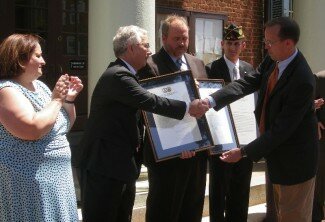Crutchfield: I’m no dredging expert
 Self-styled Republican Crutchfield (right) crossed the aisle May 6 for Mark Warner (left) in the former governor’s bid for the U.S. Senate.
Self-styled Republican Crutchfield (right) crossed the aisle May 6 for Mark Warner (left) in the former governor’s bid for the U.S. Senate.PHOTO BY LINDSAY BARNES
With some political and environmental leaders denouncing them, nothing seems to have energized the foes of a controversial $143 million water plan  quite like the unsolicited letter by William Crutchfield. Sent to the Hook in late April by the founder and chief executive of the consumer electronics company bearing his name, the letter blasts the decision-making process, but Crutchfield now suggests that he’s less savvy on MudCats and booster pumps than on business sense.
quite like the unsolicited letter by William Crutchfield. Sent to the Hook in late April by the founder and chief executive of the consumer electronics company bearing his name, the letter blasts the decision-making process, but Crutchfield now suggests that he’s less savvy on MudCats and booster pumps than on business sense.
“I don’t want to be seen as a self-appointed dredging expert,” says Crutchfield. “My concern is that some tough questions were not asked. If they had been, I suspect that all parties involved would have come to a very different conclusion.”
Not an expert? Crutchfield’s letter actually mentions two possible places to dump the dredged materials, including one that flies into the public arena tomorrow via a Hook story: an old quarry on Rio Mills Road owned by Dr. Charles Hurt.
“This is the first I’ve heard of this,” says Crutchfield in a telephone interview Monday.
So how did he know about the quarry?
“I’m a pilot,” explains Crutchfield, “and every time you fly into this airport, you fly right over it.”
It turns out that members of the Citizens for a Sustainable Water Plan, the group that’s urging dredging as a low-cost way to save both the environmental and financial costs of the $143 million plan, haven’t seen the quarry concept either.
“As soon as we read it,” says Citizens member Betty Mooney, “we’ll comment on it.”
Mooney’s group has scheduled a press conference for 6:30pm on Monday, May 19, immediately preceding the highly anticipated City Council public hearing on the water plan.
Crutchfield’s letter:
April 28, 2008
Hawes Spencer
Editor and Publisher
The Hook
100 Second Street, N.W.
Charlottesville, VA 22902
Dear Hawes:
I want to compliment you for writing and The Hook for publishing the April 3rd and April 24th articles on the controversy surrounding the Rivanna Water and Sewer Authority’s proposed $143 million water plan. You raised some very important issues which the community needs to understand.
Since the beginning of this debate, I have felt that it is a mistake not to dredge the South Rivanna reservoir. Furthermore, my instincts have been extremely uncomfortable with the concept of enlarging the Ragged Mountain dam and connecting the Ragged Mountain and South Rivanna reservoirs with a 9.5 mile pipeline.
I must preface my remarks by saying that my opinions are based on what I have read in the media and have heard in the community. I have not been privy to any of the technical discussions that officials of the Rivanna Water and Sewer Authority, City of Charlottesville and County of Albemarle have had regarding this subject. Nevertheless, it appears that the decision makers may have failed to ask the types of questions that prudent businesspeople ask when making tough decisions. Here are seven questions that initially come to my mind:
Why did the Rivanna Water and Sewer Authority seek a cost feasibility study for dredging from only one consultant? They hired a consultant, Gannett Fleming, to determine the cost of dredging. Their estimate was $145 million. However, other parties believed the cost would be significantly less. A dredging contractor was willing to do it for $21 million— 85% less. Under these circumstances, prudent businesspeople would have commissioned at least one other cost study.
Was it a conflict of interest for Gannett Fleming to provide an estimate for dredging and be asked to design the dam? The Rivanna Water and Sewer Authority asked Gannett Fleming to compete for the design of the Ragged Mountain dam.
Obviously, if dredging was determined to be a good option, there may not have been a need to design a dam. As it turned out, Gannett Fleming was awarded a $3.1 contract for dam design. Prudent businesspeople would have seen this situation as a potential conflict of interest. They would have commissioned a dredging feasibility study from a firm or firms that did not have a vested interest in the Authority’s decision not to dredge.
What is the professional qualification of the Nature Conservancy for developing this plan? Apparently, an official with the Nature Conservancy devised it. According to its website, the Nature Conservancy’s mission is “to preserve the plants, animals and natural communities that represent the diversity of life on Earth by protecting the lands and waters they need to survive.” The Nature Conservancy performs this mission admirably. However, designing municipal water systems is not one of their core competencies. Prudent businesspeople would not have based a decision on a plan developed by an organization that did not have the appropriate expertise and experience.
Did the Nature Conservancy understand the full environmental impact of their plan? It has been reported that their plan calls for clear cutting 54,000 trees over 180 acres. Apparently, the Sierra Club now understands the plan’s impact and is withdrawing its endorsement of it. Prudent businesspeople would have understood all aspects of a plan before adopting it.
How much money will local water customers pay and how large is the carbon footprint for the incremental electricity production? Little has been said about the energy needed to pump enormous quantities of water through a 9.5 mile pipeline and then up a small mountain. Prudent businesspeople would factor the financial and environmental costs of a plan that requires the use of so much electrical energy.
Has anyone in the decision-making process looked for creative as opposed to consultant-packaged, generic solutions? The best decisions are often based on creative, non-conventional ideas. For example, there is an abandoned stone quarry within walking distance of the South Rivanna reservoir’s dam. It may be possible to buy the quarry and pump sediment into it. The dewatering of the sediment might occur naturally— the sediment would sink to the bottom and the water could be pumped off the top. Another non-conventional idea would be to buy the low-lying, river-front land that includes the old UVa polo field. Because it is in the Rivanna River’s flood plain, this land probably has no development potential. Sediment could be pumped the short distance to it for drying and future sale. Prudent businesspeople would explore creative solutions like these.
What are the long-term ramifications of not dredging? Eventually, the reservoir would fill with sediment and become a giant swamp. If that were to happen, the public would demand a complex and costly remediation. Prudent businesspeople would consider long-term issues like this one.
Although the Rivanna Water and Sewer Authority’s water plan may be flawed, I do applaud them for attempting to find a long-term solution for our water needs. As I understand it, if the South Rivanna reservoir is completely dredged, our water system would revert back to the capacity that it had 40 years ago. Obviously, we need to find ways to increase our water capacity. This goal is especially important considering the possibility of a reduction in average rainfall as a result of climate change.
As the Authority moves forward with its future planning, I hope that they learn to ask the right questions.
Sincerely,
William G. Crutchfield, Jr.
#



 Had he not been
Had he not been 







Mr. Crutchfield,
I applaud your letter, your voice. I think you bring some very important issues to the surface that could’ve been easily swept past the general public. I hope some hands get slapped as a result of this and a good head, such as yours, can be placed on top of Charlottesville’s shoulders.
(Disclaimer - I worked for and with Bill Crutchfield for many years) I don’t think it matters that Bill is no dredging expert. In fact, that’s the point! Our elected and appointed leaders aren’t dredging experts, either, and it’s incumbent upon them to ask the kinds of questions Bill poses. The fact that they apparently did not is something I find quite alarming.
The phrase he uses, “prudent businesspeople” is the key. Our elected leaders need to understand that they are doing the peoples’ business and they need to use our resources (financial and natural) wisely. The person I work for now is also an entrepreneur much like Bill Crutchfield, and he has told me that his job is to ask a lot of questions. While he has an amazing thirst for knowledge, he mostly does it to make sure that the people working for him are asking the right questions to be able to answer his! Bill’s a lot like that - he’s naturally curious and expects others to be. ESPECIALLY people in positions of responsibility.
We’re in this mess because too many people look inside the box for solutions. One definition of insanity is doing the same thing over and over and expecting different results. I hope our leaders heed Bill Crutchfield’s words of advice and exercise prudence.
I’m with Mr. Crutchfield and the two posters above. Too bad it makes too much sense to get anywhere.
“One definition of insanity is doing the same thing over and over and expecting different results.” And, obviously, relying upon BoB Tucker and Overrun O’Connell to rule the RWSA is an example of insanity, too.
Since when does the Nature Conservancy fund its projects by taxing needy residents who can afford it the least? The $143 million dollar water plan is not just about water, it’s about restoring flow to the Moormans River, which would be a good thing. But the huge cost of this project will be paid for by water rate increases in Charlottesville and the urban ring in the county. Most county residents (including those who will benefit most directly from the increased flow to the Moormans) will not pay a dime. This is especially problematic when we can meet virtually all of our long-term water needs by dredging the South Fork reservoir for $120 million less than the Nature Conservancy’s plan. Wake up, everybody, just because this plan has “Nature Conservancy†stamped on it does not mean it is in the best interests of the community, especially the part of the community who will actually pay for it.
C’ville Voter is providing incorrect information.
The $143 million plan also includes infrastructure projects that are going to have to be done regardless of whether RWSA decides to do dredging or expand the Ragged Mountain dam. If you look at the breakdown of projects that are on the latest C-ville Weekly story you’ll see that raising the Ragged Mountain dam is actually just one portion of the overall costs of the plan.
Even if you dredge you still have to do something about the 13-mile pipe from Sugar Hollow to Ragged Mountain, which has broken some 17 times in the last couple years. The community is also going to have to spend millions on upgrading its water treatment plants even if it decides to dredge. You’re still going to have to replace the Ragged Mountain dam.
Show me a cost comparison of dredging plus the other projects that are required to bring the area’s water supply system up the the 21st century and then may readers will believe you.
Thanks to Water Observer for your reply. You are correct that the $143 million plan includes some needed upgrades to the system, such as improvements to the water treatment plants. However, the most expensive parts of the plan are (1) raising the Ragged Mountain Dam by an additional 45 feet and (2) building a new, 9-mile, uphill pipeline. The pipeline alone will cost around $60 million, not including the continuing costs of pumping water uphill. (This is far more than it would cost to repair the current pipeline). About 90% of the cost of the $143 million plan consists of these two components, neither of which is necessary now that we know dredging can be done for under $30 million.
Nor do you the address the question of why the neediest parts of our community should pay for improvements that are unnecessary to meet our water needs for years to come.
C’ville Voter:
The old pipeline has to be replaced regardless. It’s widely regarded as being in terrible shape. Might as well build a new one that is shorter for cheaper (SFRR to RMR) (still have to pump uphill a bit, I understand that part), and then you get the benefit of better flows in the Moorman’s River. So that leaves you with a 24Million dollar tag that’s above the cost of doing no enhancements to the overall situation such as dredging. The dredging estimate of 30M is only a one time investment that only maintains MGD, not an increase. What about in another 20 years? Dredge again for another 30M?
Lastly, as a matter of math, the two costs you say are 90% of the total are actually 41% of the total (24M (dam) + 35M (pipe) = 59M, or 41% of 143M.
Thanks for your reply, Drinker, it’s nice to be debating the facts. I’m not sure where you got your numbers but they do not match those provided by RWSA (Rivanna Water and Sewer Authority). Their numbers can be found at http://www.rivanna.org/community11.htm:
RWSA estimates that “Ragged Mountain Dam, Observatory Upgrade, and New Pipelines=$127 million or 89% of Total $142 Million 50-Year Plan”
As you noted, the current gravity fed pipeline may have to be replaced, but estimates for that are around $16 million. The proposed new pipeline will cost around $60 million when you take into account the pipeline, pumps to move the water uphill, and a new pre-treatment facility at the South Rivanna. The Observatory Hill treatment facility will have to be upgraded whatever plan is adopted, but it will cost much more to bring it to a capacity that would accommodate the water captured by the new dam.
In short, the $142 million plan is far more expensive than dredging, even taking into accounts needed repairs.
I got #s from the Cville weekly article for what they’re worth. Isn’t the O’hill facility a needed upgrade as well? Just trying to compare apples to apples here…. something that we’ve not seen much of out of this controversy. I’ve not heard the 60Mil price tag on the new pipe+pre-treatment facility, that come from RWSA too (admittedly I can’t keep track of all the #’s that are getting hurled about.)
Back to dredging: 30 mil is a one time dredge correct? If so, then what about the future (and you gotta go out 50 years, cause that’s what the approved plan calls for). How often will we dredge and what’s the cost of that?
At this point, I’m slightly neutral about how we get the need met here, but I agree with two things: I want the Moorman’s river restored (almost certainly requires the new pipe) and I want to drink local water.
Thanks,
Drinker
Yes, there are some other things that would have to be done to the system that are in the 142M projected cost. There are also a lot of costs which are not accounted for in the current scheme. For an analysis of how a less expensive and less environmentally damaging plan can be built around dredging see:
http://cvillewater.info/Water_Plan_Alternatives_Comparison.pdf
The bottom line is that in a best case scenario, adding dredging to the mix of options cuts the total cost of a 50 year plan to 80M. Worst case scenario would be 120M. In either case the environmental consequences are much better
Mr.Crutchfield,
I really appreciate your letter. In this letter says that very important issues to the surface that could’ve been easily swept past the general public. Thanks!
Kevin, thank you for finally making statements that are coming close to comparing options cost-to-cost against one another.
Now, if you would refrain from stating your opinions as facts:
“In either case the environmental consequences are much better”
This is clearly your opinion, one that some folks share no doubt, but not everyone (and not you when you voted for the plan originally) If you’d state them as your opinion you’d begin to regain a lot more credibility.
*my* opinion is that losing the trail and some forest is a relatively small cost compared to restoring a state wild and scenic river. Again, this is *my* opinion, maybe shared but maybe not.
Drinker, reasonable people can differ on their own environmental priorities, but for the regulators who approve a water supply project, the criteria are clear: wetlands impact, stream impact and endangered species impact. These impacts are evaluated before the project begins and do not count mitigation (this is why we were told that raising the south fork reservoir by 4 feet would not be approved, even though it created more wetlands when it was done than would be inundated at the start, and would have cost a fraction of any of these options). There is no question that a lower RMR reservoir pool height will inundate less footage of streams. Interestingly, the trees dont count in the impact criteria used by the regulators, but the trails do (cultural resources).
Yes, I did vote for the current scheme. That is because we were told over and over again that dredging would be too expensive. It was only after FOIA’ing Rivanna that we found that two dredging firms had come to Rivanna offering to do the job for a tenth of what the consultants told us it would cost. Elected officials and the public were never told this.
We were also told when I voted for the current scheme that the RMR would be raised in phases, with the first phase adding an additional 13-20 feet, which would give us 20 years of additional storage and not require the very expensive pipeline to be built for several decades - when there would be more users to pay for it. I figured that would give us plenty of time to figure out why dredging was so expensive and to find a cheaper alternative. However our FOIAs also found that almost immediately after the vote, the consultants started lobbying Rivanna to go with the full 45 feet.
The cost of this scheme will require doubling of our water bills (again) in the next 13 years to build a system we dont really need for 50 years - and given the inflated demand figures used by Gannett Fleming, it is doubtful we will even need it in 50 years. Also note that when I say that your water bill will double - that’s just to do this project - it does not count all the other system improvements, salary increases etc.
The standard retort from the environmental establishment is “high water bills are good - people will use less water”. But it wont matter! These are sunk infrastructure costs which have to be paid regardless of how much water we use. People are already using less water. Has your water bill gone down?
Listen, I don’t disagree with everything you’ve said here (at least the factual parts) or anywhere else for this matter, only some things. What I disagree with is the generalizations and assumptions about people and process that you, some others, and this publication have been making lately. Case in point, you write above: “The standard retort from the environmental establishment is”. I’m firmly seated in the environmental establishment, as are many of my associates, friends, etc., and I’ve NEVER made that statement or heard it. I think it’s crystal clear that in this case as in most, there is NO standard retort.
OK - point taken - instead of “the standard retort” I should have said “a common retort”, or perhaps just “a retort I have heard so many times that I wonder what City some of these good folks live in”
[...] who has recently leapt into political and water issues, stresses that he saw his 300-foot-stretch of the Olympic torch relay (which was suspended for [...]
[...] down in January, former City Councilor Kendra Hamilton re-emerged yesterday to add her voice to the growing calls to reconsider the Rivanna Water & Sewer Authority’s strategy of building a [...]